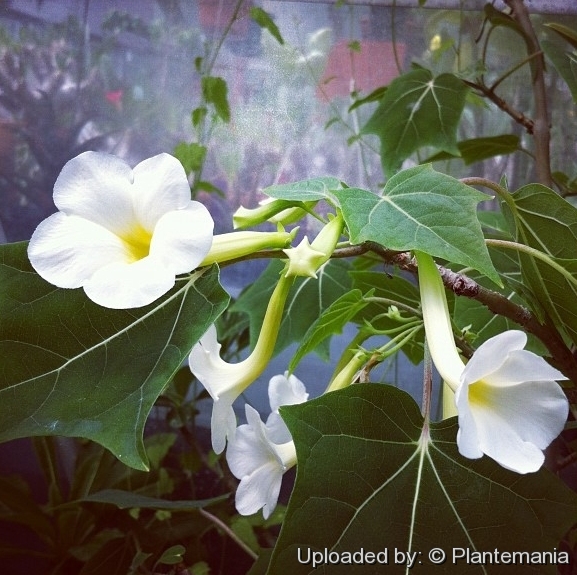Accepted Scientific Name: Uncarina leptocarpa (Decne.) Ihlenf. & Straka
Z. Bot. 50(2): 157 1962.

Uncaria leptocarpa (Uncarina leptocarpa) Photo by: © Plantemania
Uncarina leptocarpa is the only white blooning species. It is quite rare in cultivation, but will flower at about 50 cm. The flowers are white with a yellow throat.
Origin and Habitat: Uncarina leptocarpaSN|33357]]SN|33357]] grows in the tropical Morondava, Malaimbandy, Mahajanga, North of Toliara, Madagascar.
Habitat and ecology: This species grows on calcareous soil and between limestone rocks.
Synonyms:
Description: Uncarina leptocarpaSN|28285]]SN|33357]] is a shrub or dwarf caudiciform trees, ficus-like in habit, growing up to 3 metres, occasionally to 7,5 metres tall with a trunk up to 30 cm in diameter developing a comparatively dense crown of overhanging branches, to 2.5 m, with very large irregularly shaped subterranean tuber. It is the only white blooming species in the genus, but plants have a prolonged flowering period and will flower at an early age at about 50 cm. Uncarina leptocarpa is very rare in cultivation.
Leaves: Pentagonal to slightly palmate, with small acute lobes, the 2 basal lobes often indistinct, long petiolate, finely hairy, balade (lamina) 6-13 cm long, up to 14 cm wide. Margin entire, upper face with sparse mucilage-galnde, on the lower face more numerous and mainly occurring along the veins. The leaves are deciduous during the winter resting season.
Inflorescences (cymes): 1 to 3 flowered, not forming dense clusters.
Flowers: Solitary, in axils of upper leaves white with yellow throat, long pedicellate. Tube 6 to 7 cm long.
Fruits: Laterally much compressed, body in lateral view ovate and with a long narrow oblong beak, to 5 x 5 cm. Spines dimorphic: Barbed spines (very prickly hooks) 5 in each row, to 15 mm, bases longitudinally much broadened and fused, forming crests to 5 mm high (don't touch this fruit unless you want to spend some time trying to remove it from your fingers). Simple spines numerous, about 3 mm long, often much reduced, false septa absent.
Seeds:Obovate-triangular, 8 mm long and wide, wings 1.5 mm.
Related species: Uncarina leptocarpaSN|33357]]SN|33357]] is related to Uncarina perrieri, but the latter has yellow flowers and more prominent simple spines on the fruits. Moreover, habit and leaves are distinctly larger. The fruits are very similar to Uncarina peltataSN|33357]]SN|28285]] that mainly differs in its more tree-like habit with sparsely branched crown, the more numerous barbed spines (about 7 in each row) and the lack of simple spines on the fruits.
Bibliography: Major references and further lectures
1) Werner Rauh “Succulent and xerophytic plants of Madagascar”, Volume 1 Strawberry Press, 1995
2) Urs Eggli “Illustrated Handbook of Succulent Plants: Dicotyledons” Springer Science & Business Media, 2002
Cultivation and Propagation: Uncarinias are easy to grow heat resistant plant, which grow better than the average. Their attractiveness is further enhanced because they will flourish very easily in any pseudo-tropical environment. It can tolerate neglect, and as soon as you pay it a little attention (like repotting or fertilizing) it recovers and puts out plentiful new growth. They will tolerate intense heat and sun, when provided with adequate water, but must be protected from frost.
Growth rate: These plants can grow quite quickly if provided with adequate water, warmth and root run.
Soil: It needs a a rich, very well drained potting medium (add pumice, vulcanite, and perlite).
Waterings: It should be watered plentifully in Summer and kept drier in Winter. This species like all Uncarinias, is sensitive to excess moisture, and should be kept on the dry side. It rot easily and do not like any water when it has no leaves.
Fertilization: Use diluted fertilizer on young plants to speed up growth.
Exposure: They do best when grown in part shade to full sun. G
Hardiness: Due to their Madagascan origin keep warm in winter, the minimum safe average temperature is 10°C, although they can go lower for short periods (cannot endure temperatures below 2° C). If grown outdoors they will probably grow back from roots, if frozen. They are quite heat tolerant, and survive easily temps above 45° in summer, without dropping leaves.
Bonsai/caudex culture: Lifting the thickened root system periodically creates a cool, gnarled bonsai look.
Reproduction: Seeds, and they can be reproduced by cuttings as well.










